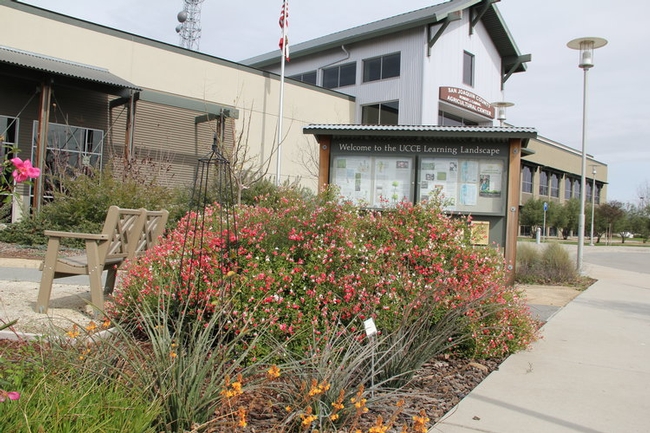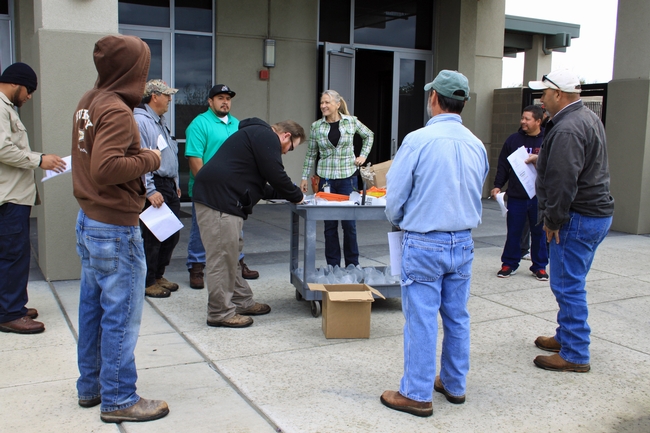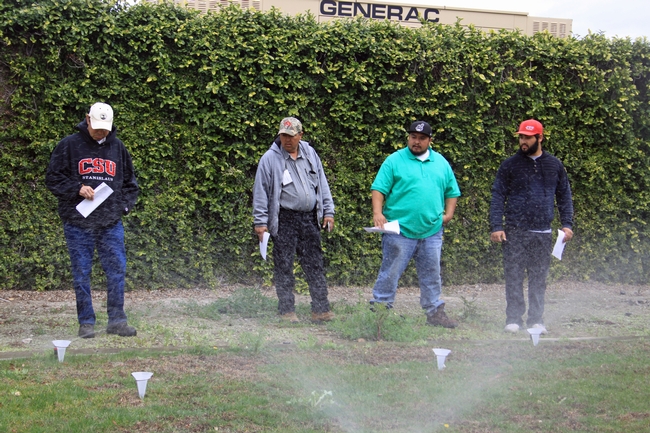
Posts Tagged: Karrie Reid
San Joaquin County UCCE one of two sites in California for sustainable rose trials
San Joaquin County UC Cooperative Extension in Stockton maintains pesticide-free roses as one of two trial sites in California for the American Rose Trials for Sustainability, reported Angelina Dequina in the Daily Titan. The other California location is at California State University, Fullerton.
Since 2012, the American Rose Trials for Sustainability has conducted scientific research to determine the best rose cultivation techniques for gardeners in each region of the U.S. The roses in the trial plots are grown with minimal care; the only inputs are water and compost. The San Joaquin County roses are maintained by UC Master Gardeners in the UCCE Learning Landscape, which beautifies the Robert J. Cabral Agricultural Center and features a series of small, themed, climate-appropriate gardens.
The Learning Landscape is used for educational Open Garden Days and to teach a variety of workshops for landscape professionals. The public is welcome to stroll the gardens seven days a week during daylight hours. The facility is at 2101 E. Earhart Ave. in Stockton.
Project lead Karrie Reid, UCCE San Joaquin County environmental horticulture advisor, said the rose trials are integral to the marketing of rose cultivars, according to the Daily Titan article.
Once the two-year trial ends, the trial gardens may keep the roses they planted.
San Joaquin County gardeners boost business with UC Cooperative Extension Green Gardener qualification
For a healthier family and environment, San Joaquin County homeowners can select a UC-qualified Green Gardener to take care of their lawns and landscapes.
Green Gardeners are landscape professionals who are trained and tested on up-to-date, environmentally friendly, science-based landscape practices.
“We're improving the knowledge and skill sets of workers who manage an enormous amount of urban acreage,” said Karrie Reid, the UC Cooperative Extension horticulture advisor in San Joaquin County. “We're helping them understand that they have the power to effect change in water conservation, quality of storm water runoff, and the amount of pesticides that are in the environment.”
To become qualified as a Green Gardener, participants attend classes eight weeknight evenings and two Saturday mornings. The first module addresses the importance of healthy soil for healthy landscapes. UC Cooperative Extension scientists provide training on soil building, pest control and green waste management. The second module focuses on mastering efficient irrigation and conducting an irrigation audit. The final sessions focus on plants in the California landscape, including turfgrass, trees and shrubs.
Because the Green Gardener program is partially funded by a dumping fee paid by residents to the county landfill, green waste management is a key component of the program.
“We have to reduce our green waste,” Reid said. “Our urban soils are in need of organic matter. By building soil with green waste, we are solving two problems that inhibit our urban landscapes' sustainability.”
Beginning with Module 1, the Green Gardener qualification program is being held for the fifth time Jan. 16 to March 12, 2018. The registration deadline is Jan. 12.
On the first day of an earlier session, a landscaper wondered aloud if the $90 fee and, particularly, the time commitment, would be worth it. “Well, I know the answer is that it was worth it,” he said.

One Green Gardener, Jacob Wilson, wrote to Reid about a visit to a customer's property after a four-week break and found the lawn was significantly greener.
“I asked the customer if she had her sprinklers repaired,” Wilson said. “She said, ‘No, my sister adjusted the water schedule to two or three times during the night with shorter watering duration each time instead of watering once; like you said.'”
As his customer made her way back to the house, Wilson said he was feeling more like a professional.
Home gardeners aren't the only ones who can take advantage of the program. Reid has reached out to landscape professionals working in the county parks department and school districts. There are landscapers who tend apartment complex landscapes, commercial building landscapes, street medians and highway rights-of-way.
“I successfully pitched the program to the Sherriff's Department for their grounds landscape personnel,” Reid said.
For more information, visit the Green Gardener of San Joaquin County website at http://ucanr.edu/sites/GreenGardener.
6 ways to reduce water use without killing your garden

For homeowners, there are six key things to do to conserve landscape water, says Karrie Reid, UC ANR Cooperative Extension advisor, in San Joaquin County. Reid gives the following six tips:
- Tune up your irrigation system right away. When water is efficiently and accurately applied, less water is needed to keep plants healthy. Spray heads can get knocked out of alignment and end up spraying the sidewalk, street or driveway and running to the gutter. Check all spray heads to ensure they are hitting the target and twist those that aren't back into place. Some heads have adjustable angles of spray, which can be fixed with a tool available at a hardware store. Look for cocked heads, which spray water up into the air, and sprays blocked by grass or those that have sunk below grade. Make sure all spray heads are made by the same manufacturer and are from the same line so they deliver water at the same rate, otherwise they'll leave dry spots. Low-volume spray heads or rotators deliver water more efficiently.
- Water the whole root zone. On allowed watering days, irrigate until the water reaches 12 inches deep for grass, 12 to 18 inches for shrub and perennials, and 12 to 24 inches for trees. This provides a greater reservoir of water for the plants to draw from, and many will be able to get by on weekly, twice-monthly or monthly irrigation if they are conditioned to send their roots deep. To check the watering depth, use a soil probe or push a long screwdriver into the ground. The depth it reaches easily indicates how deeply the water has infiltrated.
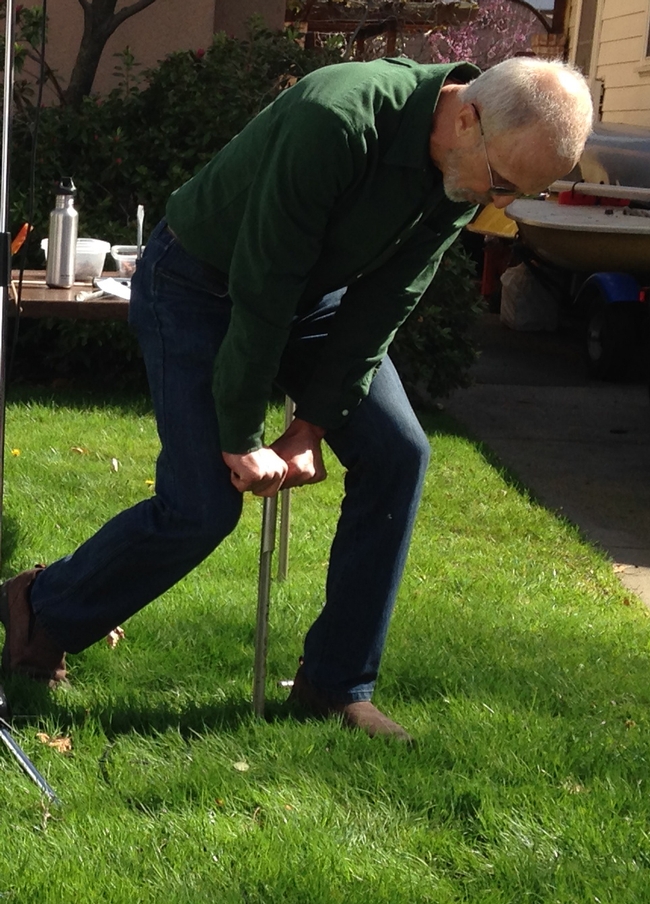 To check the watering depth, use a soil probe.
To check the watering depth, use a soil probe. - Avoid wasting water to runoff. If water runs off before the watering cycle finishes, split the cycle time. Set the timer to water in two, three or even four cycles at least an hour apart to allow the water to soak in. To ensure water isn't flowing below the root zone, check the watering depth after each cycle.
An irrigation scheduling worksheet created by Loren Oki, UC ANR Cooperative Extension specialist in the Department of Plant Sciences at UC Davis, and Darren Haver, UC ANR Cooperative Extension advisor in Orange County, helps fine tune irrigation timing. The worksheet is available for free online at the Center for Urban Horticulture website http://www.ccuh.ucdavis.edu.
- Switch to inline drip tubing for beds. Drip irrigation applies water where it is needed with less loss to the air. Be sure to lay tubing so water reaches plants' entire root zone.
- MULCH, MULCH, MULCH. Adding 3 or 4 inches of organic material such as wood chips, shredded bark or bark nuggets will improve soil health while retaining water and lowering stress on your plants. Place mulch away from the street curb to prevent heavy rains from washing it into the storm drains.
- Replace water-needy plants with low water users in the fall. All plants use a lot of water to get established when they are planted in the spring and summer, and for about a year after. Trees may need extra water for several years until their roots have grown well into the surrounding soil. By waiting until temperatures cool in the fall to plant, it will be easier to abide by the water restrictions. It's also important to use hydrozoning, which means placing plants with the same water needs on the same valve. Otherwise, irrigating to the thirstiest plants on that station will give other plants more water than they need.
 Inline drip tubing applies water where it is needed.
Inline drip tubing applies water where it is needed.
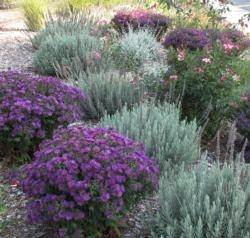
Grasscycling can help Californians conserve water

In short, grasscycling involves leaving grass clippings on the lawn, rather than collecting them in a bag and shipping them off to a landfill.
“The clippings sift down to the soil surface and act like a mulch, reducing water evaporation so you can cut back on irrigation,” said Karrie Reid, UC ANR Cooperative Extension environmental horticulture advisor in San Joaquin County. “This is a simple and elegant way to save water that requires very little extra effort.”
If you don't have a mulching mower, Reid says, “It's probably time to replace the mower.” As an alternative, a mulching blade can be attached the bottom of most mowers. The special blade makes a second cut when mowing over grass, cutting grass clippings into finer pieces.
In most California climates, mowing once a week with a mulching mower is sufficient. If grass is growing so quickly a once-per-week mowing cuts off more than one-third of the blade, it's a sign that too much water is being applied.
In addition to reducing water use, grasscycling cuts down on fertilizer needs.
“As the clippings break down, nutrients are returned to the soil,” Reid said. “Most of the fertilizer that is applied to lawns ends up in the leaf blades, so it only makes sense to retain as much of that on the lawn as possible.”
A five-page UC ANR publication on mowing and grasscycling is available for free download from the UC ANR Catalog. The publication includes a table with mower height settings for the most common types of turf grass grown in California.
In addition to working with horticulture professionals, Reid serves as advisor to the coordinator and volunteers of the UC Master Gardener program in San Joaquin County. Master Gardeners are UC ANR volunteers who are trained by UC academics in sustainable landscape, ornamental tree and garden development and maintenance.
More than 6,000 volunteer Master Gardeners form a network to disseminate research-based gardening information across the state, donating upwards of 350,000 hours of time each year.
An initiative to improve California water quality, quantity and security is part of the UC Division of Agriculture and Natural Resources Strategic Vision 2025.

